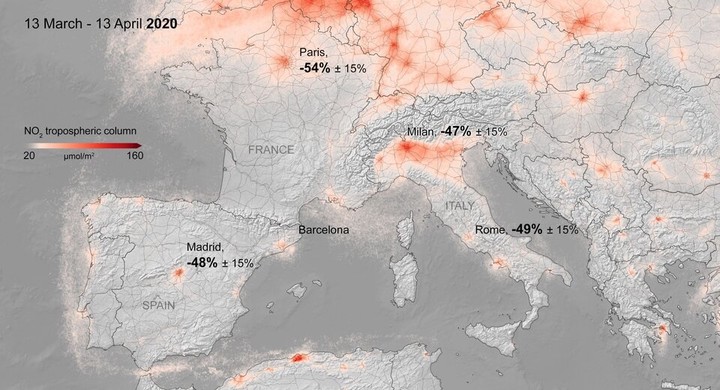The Cool Part about Global Pollution
 Decrease of NO$_2$ levels during this 2020 spring vs the previous year. (Image: © ESA/Copernicus Sentinel data (2019-20), processed by KNMI/ESA)
Decrease of NO$_2$ levels during this 2020 spring vs the previous year. (Image: © ESA/Copernicus Sentinel data (2019-20), processed by KNMI/ESA)
Restating some obvious facts about the current climate, like the increase of CO$_2$ concentration in the air, leaves out an interesting confounding factor around humanities insatiable desire for carbon products.
We don’t need need to drill the arctic ice or measure the spectral radiance to see the harmful effect of disturbing the balance of gases in the atmosphere. However, there are only a few moments in humanities recent history when the normal order is disturbed, and we can see the more deeply what are the gears of the global system (we’ll limit ourselves to climate for now).
Models and the world
Humanity is used to building models that fit observational data, create experiments, if possible, and evaluate the predictive properties. Models cannot be proven right, but they can be evaluated as being wrong. This is when the de-facto-standard set of equations is found not being able to explain some new observational data.
But that shift from old to new should not be feared, but rather cheered. It signifies the progress of establishing the underlying true model.
The world has moved from the beauty of the 17th century Newtonian invariance of dynamics, to Maxwell’s/Lorentz transformation to “fix the bug/trick when dealing with electromagnetism” in the previous model, to Einsteins special and general relativity. And without the latter our GPS would fail in their function after 2 minutes.
So what are the modern-day equivalents of Mercury’s orbital path and do we really need to travel to an eclipse this year?
Planes and Clouds
The increase of carbon consumption by humanity has also aided in polluting the atmosphere with particulate. Since we were kids, we were told how the greenhouse gases act as a blanket to trap heat, not letting it escape in the abyss of the cosmos. Extending this train of thought, the additional matter, we pollute the air with, should further increase this effect. Which is cool as a hypothesis, especially as it feels like we are doing science.
However, after the interventions in air flights for 3 days after 9/11 showed that decreasing the pollution, or so-called contrails, actually had a significant impact on the temperature swings during the days. In essence, it altered the colour and thickness of this blanket and resulted in the cooler parts of the day to be colder, but the hot - hotter - increasing this difference by 1$^{\circ}$C. So let’s not think that flying can fix our warming problem.
In an opposite effect, the eruption of volcanoes provide us with an intervention sample, fixing the particulate node in our “world-model-graph” to a value in the opposite direction. Adding an ash cloud to the atmosphere does cool the surface temporarily down. Bringing us to the internally conflicting truth that some pollution does provide us with temporary relief, giving us slack to tackle the overwhelming freight train of global warming.
Corona chills
So now, when you go out for your daily exercise in the evening, still bringing an extra layer and not feeling the spring warmth, do check your temperature, but also consider it being an effect of the month-long lower economic activity that the current times have enforced. And enjoy the cleaner air our outdoors now provides.
What other nodes in our graph does this affect and what effects will this bring?
The norm has unavoidably changed and we should mentally prepare that there is no going back. Then again, when has humanity forgotten the pain and suffering so quickly before? In the wake of this unplanned intervention, we can find that it is the right moment to push for change, changing policy that would otherwise stagnate to the lasting status quo.
Let’s rebuild a bit more antifragile this time around.
If you enjoyed this type of nuggets, consider signing up to the newsletter!